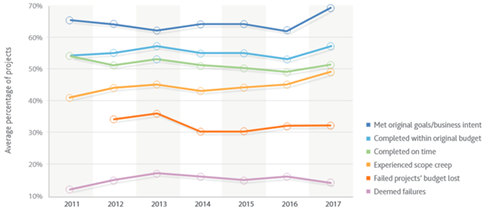In April 2018, furious TSB customers found themselves unable to access their accounts following a failed system migration; despite planning, experience and no doubt a fleet of internal auditors it becomes the latest addition to a plethora of IT projects that have nose-dived spectacularly. But why? And does it project assurance really add value?
This paper explores the topic of IT project assurance through a series of questions that audit leaders may find themselves asking of the person in the mirror or in candid discussion at networking events.
A 2017 report by the Project Management Institute (PMI) surveying over 3000 professionals identified that whilst 14% of projects were total failures, a further 49% were delivered late, 43% had budget overruns and 31% didn’t meet their goals. Which begs the question do any succeed? Thankfully yes, almost 70% of projects were successful. The PMI looks at benefit realisation to define success not limited to the traditional measures of scope, time and cost.

The table below looks at common reasons for projects to fail and suggests ways in which auditors can recommend mitigation's before failure effects are realised.
Common reasons for failure
|
Ways to mitigate
|
| Changing priorities. Even when delivered as requested, a project might not meet the needs of a changing organisation. |
Align project scope to strategy – review and realign when change is agreed regardless of the phase of the project. For complex and large organisations use a programme office to co-ordinate activity. |
| Poor requirement definition. Unclear or unrealistic specifications from the business will doom even the best project to failure as it’s unlikely to deliver a system that is fit for purpose. |
Identify and involve all stakeholders in defining requirements – from decision makers to end users, programmers and architects – the business states ‘what’ is needed with IT… |
'A smooth sea never made a skilful sailor'
- Franklin D Roosevelt